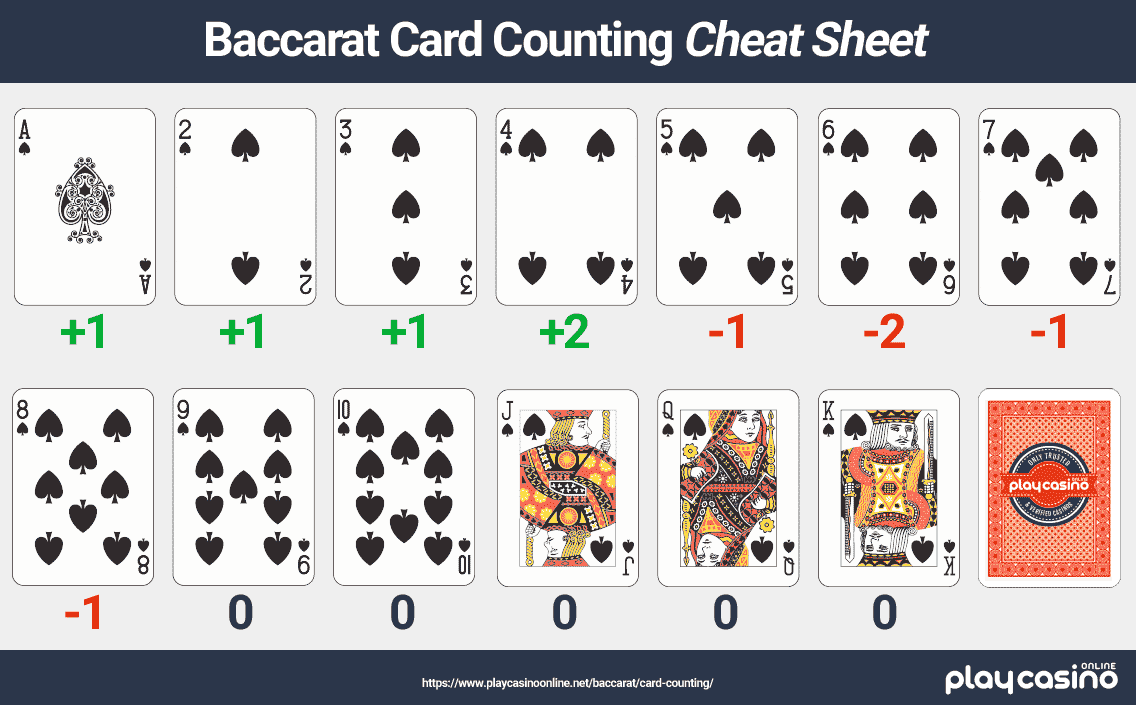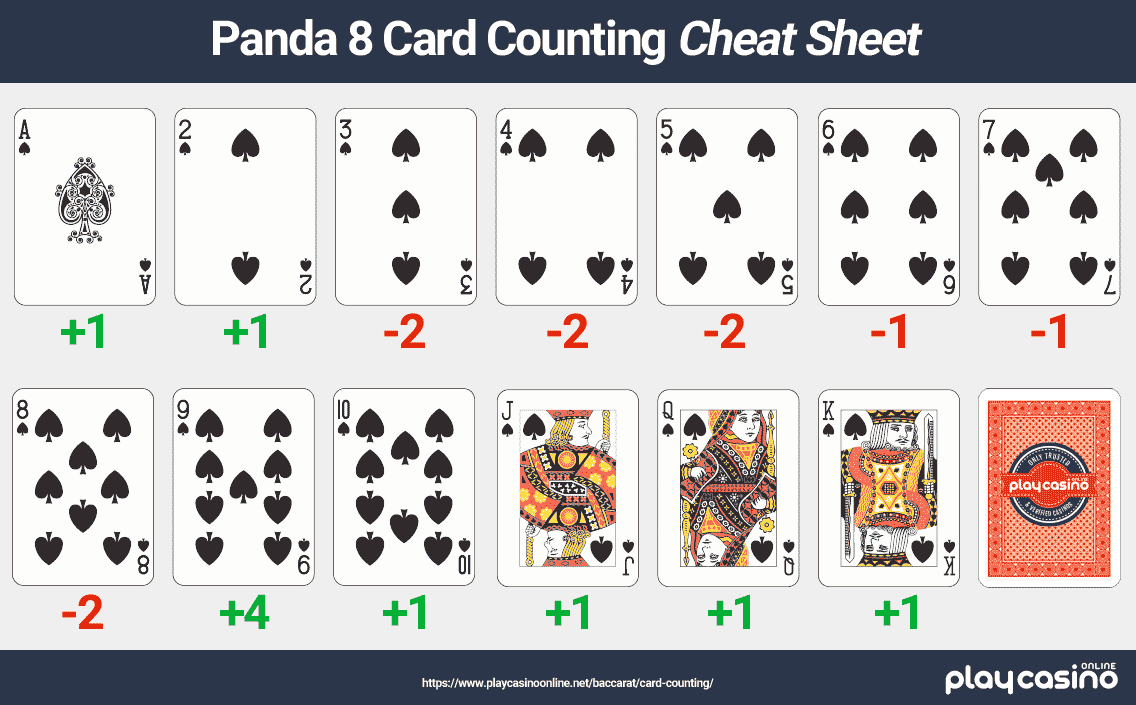Contrary to popular belief, there are effective ways to count cards in Baccarat, though it’s different than card counting in other games.
Counting cards is a method used in a number of gambling games used to make an approximation about the nature of the cards left in the deck or shoe.
While card counting is a technique most well known for being used in the game of blackjack (see how to count cards in Blackjack), there are three main ways that the technique can be used in Baccarat. We’re going to break down how all three of these systems for card counting work in this game and how you can apply all three to playing in online casinos with live dealers or in land-based games.
The Basic Counting System
One advantage of card counting in Baccarat, compared to counting cards in a game like blackjack, is that there aren’t really multiple systems to contend with and choose from. Instead, there’s really only one method that’s mathematically proven for counting cards in this game. Once you learn it, you’ve learned everything there is to learn about the basic counting system.
In line with the Fundamental Theorem of Baccarat Strategy, you’ll use this system by letting it tell you when you should go with the player bet instead of the banker bet. The idea is that you’ll stick with the banker bet normally, but this system will give you an indicator of when the player bet will give you a better payout rate.
Like any other system, card counting by itself will not make you profitable against the casino, but it will help to minimize your house advantage and maximize your chances of coming out on top in your session.
How to Use the Basic Counting System
The following will briefly summarize how to use this system for counting cards to determine when the player bet is better than the banker bet. This is based on a game with six or eight decks, but you can make an adjustment to make it work for single-deck games, which we’ll address in this summary.
- When you start with a fresh shoe of cards (or deck of cards), then you’ll mentally begin with the number zero.
- When each card is dealt on the table, you’ll adjust your count accordingly based on the chart of values that we’ll list below.
- The number you’re keeping running in your head is the count, but you’ll need to convert that to the true count by dividing by the approximate number of decks left in the shoe. For example, if there are 4 decks left with a count of 20, then the true count is 20 / 4, which is 5.
- If the true count is higher than 15 in a game with six or more decks, then that’s when you should switch from the banker bet to the player bet.
- In a single-deck game, you’ll change to the player bet when the count is higher than 11 instead.
- When there’s a new deck or shoe brought to the game, you start back over with a count of zero.
Conceptually, this is all you need to know to make this counting system work. However, you also need to know the actual values of the cards for this system, and you’ll need to memorize the following chart along those lines:
| Card Rank | A, 2, 3 | 4 | 5, 7, 8 | 6 | 9, T, J, Q, K |
| Count Value | +1 | +2 | -1 | -2 | 0 |
So if the count is 10 and a 4 is dealt, then you’ll add 2 for a new count of 12. If a king is then dealt, the count doesn’t change because a king doesn’t affect the count. This can take some practice to learn, but it’s a good way to drop the house edge a bit.

Introducing EZ Baccarat
There’s a variation of Baccarat called EZ Baccarat that you’ll often see in live dealer casinos, whether online or in land-based facilities. The game has been changed around slightly so that there is no commission on the banker wager, and it pays 1:1 just like the player bet. To compensate for this change in the rules, players who bet on the banker and win with three cards that add up to a score of seven points will push instead of winning.
Players should stick with a basic strategy of playing the banker bet in this style of the game since it has a house advantage of 1.02 percent, which is better than the player wager in most cases.
However, what’s particularly important about this game is that it can have one (or both) of two side bets called the Dragon 7 and Panda 8. While most side bets in casino games are serious losing propositions, there’s an exception here because there are methods to count cards for each of these bets and discover when they are profitable for the player to wager on.
Both of the following counting systems are mathematically proven to be able to get an advantage against the house. However, not all live dealer casinos carry EZ Baccarat games where these wagers are used, so you might have to look around a bit to find a game to target with these systems.
Card Counting for the Dragon 7
The Dragon 7 is a side bet that pays 40:1 if the banker hand wins with three cards and a total score of seven. Typically, it has an average house advantage of about 7.6 percent, so we’re not always going to take the bet. Instead, we’ll just use this card counting approach to make the bet when we know it’s profitable.
Since all EZ Baccarat games use shoes of eight decks, it really simplifies card counting since you don’t have to learn multiple points or even really do anything special outside of learning the card values. On top of that, learning the card values is significantly easier for card counting the Dragon 7 than it is for the basic counting system that we described above. Consider the following values:
| Card Rank | A, 2, 3 | 4, 5, 6, 7 | 8, 9 | T, J, Q, K |
| Count Value | 0 | -1 | +2 | 0 |
To give you some statistics, you’ll end up with a house edge of a little over 8 percent on average each time you make this bet with a true count of 4 or higher. This will happen in just under 10 percent of all hands.

Card Counting for the Panda 8
The Panda 8 works similarly to the Dragon 7 in terms of how the side bet actually works. If the player hand wins in this game with a total of eight made of three cards, then the Panda 8 side bet pays at a rate of 25:1. The house edge on this wager is typically about 10.2 percent, which is pretty huge. However, much like the system proposed above, we’re only going to make the bet when we know it will give us a net profit, on average, to do so.
Counting this bet, however, is significantly more difficult than counting for the Dragon 7 or even the basic count that we described earlier. Consider the values for this system:
| Card Rank | A, 2 | 3, 4, 5 | 6, 7 | 8 | 9 | T, J, Q, K |
| Count Value | +1 | -2 | -1 | -2 | +4 | +1 |
As you can see, there’s a lot more to learn, and it’s much easier to make a significant counting mistake with this system. Nonetheless, when you have a true count of more than 10, then you’ll have an advantage against the house. Counting the Panda 8 is only about 40 percent as profitable as counting the Dragon 7 in terms of your actual hourly trying to exploit the game, so if you have to choose between one and the other, you should go with the Dragon 7 instead.

Training to Count Cards
If you’re the type of player who is serious about getting in on the action with this game and learning these counting systems, then you’re going to have to put in a considerable amount of time practicing. That’s simply the nature of counting cards in any casino game, and if you want the results, you have to put in the work.
With that having been said, we have a suggested method here that you can use to speed up your training significantly compared to just trying to learn to do it by playing through Baccarat hands. Get yourself a normal, 52-card deck and practice with this approach, and you’ll be well on your way to being able to count cards effortlessly in real time at the tables within a few weeks.
- Start with a count of zero, and deal one card at a time from the deck while mentally keeping up with the count as you go. Start off by going as slow as you need to.
- With this method, you should end up with a count of zero when you finish the deck. If you don’t have a count of zero when you finish, then you made a mistake somewhere.
- Continue repeating this exercise until you’re able to do it very quickly.
- Repeat the above exercise while dealing two cards at a time until you’re able to do it super quickly.
- Make sure to keep up with the count mentally and without having to say it aloud. You don’t want to train yourself to have to speak the count, especially if you plan on playing in a land-based game at some point.
- When you can reliably and accurately count down a deck one card at a time within 60 seconds and two cards at a time in 90 seconds, then you’re prepared to use what you’ve learned in real games.
Something that’s great about this method is that it’s like riding a bicycle. Once you really learn to count through this approach, it will be something you can come back to and pick up where you’d left off, even if it’s been months or years since you played Baccarat last.
Overview
There are a few different possibilities for learning to count cards in Baccarat. While the basic system is good for all games, the systems for the Dragon 7 and Panda 8 require you to find the EZ Baccarat variation, which you’ll only find online in live casinos. It’s not the most common game in the world, but you’ll be able to find it if you look. Make sure that you put the time in practicing before you try to use these systems at the tables, and you’ll be well on your way to maximizing your chances of winning at this game.






